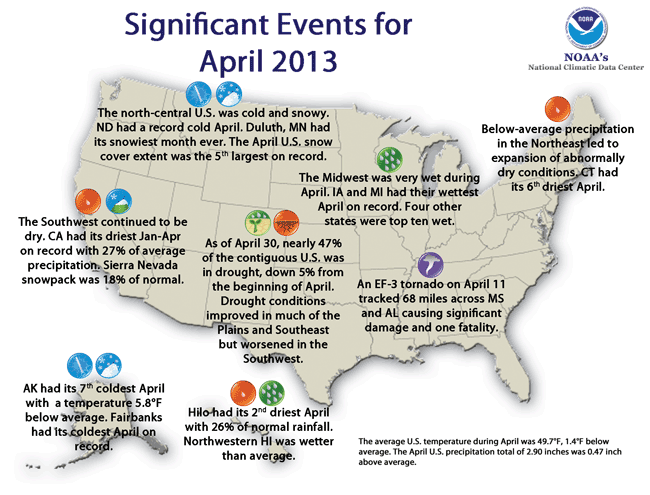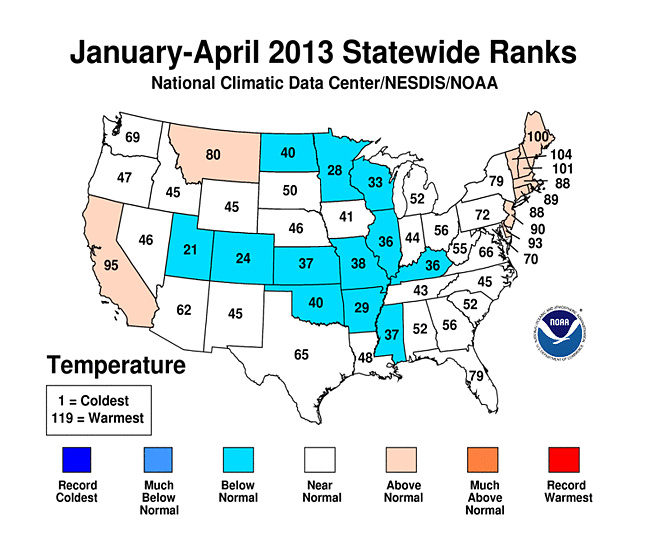Monthly Report Summary Information
The Monthly Report Summary Information is a synopsis of the collection of national and global summaries released each month.
National Summary Information - April 2013
See Full Report
Contiguous U.S. cool and wet with more than usual snow on the ground
April temperatures coolest since 1997. Storms brought record-breaking precipitation to the central United States. April snow cover extent 5th largest on record
The average temperature for the contiguous U.S. during April was 49.7°F, 1.4°F below the 20th century average, making it the 23rd coolest April on record. national temperature was near the 20th Century average
The April nationally-averaged precipitation total of 2.90 inches was 0.47 inch above the 20th Century average and tied with 1953 as the 19th wettest April on record. Drought improved for parts of the Plains and Southeast, but worsened in the Southwest.

Significant climate events for April 2013.
Click image to enlarge, or click here for the National Overview.
Note: The April Monthly Climate Report for the United States has several pages of supplemental information and data regarding some of the weather/climate events from the month.
U.S. climate highlights: April
- The Below-average temperatures were also present for the Northern and Central Rockies, the Southern Plains, and the Mississippi River Valley.
- Near and above-average California had its 12th warmest April on record with a statewide temperature 3.7°F above average.
- The Northwest, Midwest, and the Southeast were Wisconsin each had one of the ten wettest Aprils on record.
- The abnormally high precipitation in the central U.S. resulted in several rivers in Illinois, Iowa, and Michigan reaching record high levels, with widespread flooding observed. The Mississippi River at St. Louis, Missouri also reached flood stage after dropping to near-record low levels at the beginning of the year.
- Below-average precipitation was observed in the Southwest and Northeast. New Mexico had its 12th driest April, while Connecticut and Rhode Island had their 6th and 11th driest April, respectively.
- Alaska was much cooler than average during April, with a statewide average temperature 5.8°F below the 1971-2000 average. This was the 7th coldest April in the 96-year period of record for the state, and the coldest April since 1985. The average temperature in Fairbanks was 14.5°F below normal and it was the coldest April on record for the city.
- According to the April 30 U.S. Drought Monitor report, 46.9 percent of the contiguous U.S. was experiencing moderate-to-exceptional drought, smaller than the 51.9 percent at the beginning of the month. Despite the flooding in parts of the Midwest, drought conditions eased for portions of the Plains and Southeast, but worsened and expanded in the Southwest.
- Several late-season snow storms impacted the U.S. bringing record-breaking snowfall to the central United States. According to data from the Rutgers Global Snow Lab, the April snow cover extent for the contiguous U.S. was approximately 209,000 square miles above average, and the 5th largest April snow cover extent in the 47-year period of record. However, very low snowpack continued in parts of the West, with only 18 percent of normal snowpack reported in the Sierra Nevada Mountains.
U.S. climate highlights: Spring-to-Date (March — April)
- The first two months of the spring season, March-April, were cooler than average for the contiguous United States. The nationally-averaged temperature for the two-month period was 45.2°F, 1.1°F below the 20th century average and the 33rd coolest March-April on record. This marked the coldest March-April since 1996.
- Below-average temperatures stretched from the Northern Plains to the Southeast, with 16 states having one of the ten coolest March-April periods on record. Above-average temperatures occurred in the Northeast and West.
U.S. climate highlights: Year-to-Date (January — April)
- The average temperature for the contiguous U.S. for the year-to-date period was 39.3°F, which was near the 20th Century average. Above-average temperatures were observed in parts of the West and Northeast.
- The total average precipitation over the contiguous U.S. for the months January through April was less than 2 percent below the 20th Century average.
- Illinois also had a top ten wettest year-to-date period.
- Much of the western and northeastern U.S. was Vermont also had a top ten dry January-April.
 NOAA's National Centers for Environmental Information
NOAA's National Centers for Environmental Information




